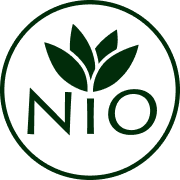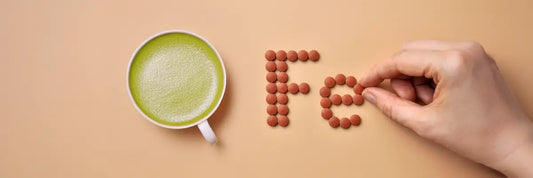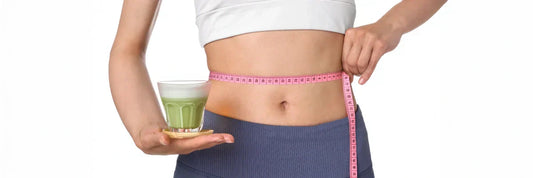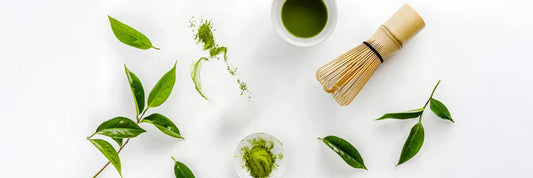What is Tencha? 🤔
Behind every great success story, there's an unseen face. Someone who works hard but never steps into the limelight themselves. In the case of matcha, the secret lies in tencha, the leaves that are ground to produce the famous green powder.
If you were to grind any old tea leaves into a powder, the flavor would be incredibly bitter, while premium matcha is smooth and savory. So why are tencha leaves so special? That’s exactly what we’re going to find out today.
We’ll take a look at how tencha is made, why tencha leaves are becoming so expensive and why you will almost never find a tencha tea.
Let’s get grinding! 🍵
What is tencha?
So what is tencha? The short answer is, they are the leaves to make matcha. The tea leaves have their stems and veins removed to easily fit into granite mills. But there is so much more to tencha leaves than that.
They are carefully grown, selected and processed to make them the perfect fit for matcha. They are even shaped and sized to fit in the standard granite matcha mills. Too big or too stemmy and they would create a jam in the mill.
Tencha meaning
Before we go into detail about how tencha leaves are made, let’s first discuss the tencha meaning. It sounds very similar to “sencha” but the tencha meaning is entirely different.
The name tencha essentially means “tea for grinding” indicating the tencha leaves are really mean to be used to make matcha and not infused themselves like sencha which means “simmering tea”.
Starting with the Tencha plant

So where do the tencha leaves come from? The tencha plant is the same plant used to make sencha, gyokuro and even black teas. The matcha tea plant, camelia sinensis, is an evergreen flowering shrub native to Southeast Asia and China. It has been cultivated in Japan for close to 1,000 years and now all the best tencha in the world is grown in Japan.
What makes the tencha plant different from most plants used to make Japanese green tea is the fact that it is shaded for 3 weeks or more leading up to the harvest.
Why is the tencha plant shaded?
When the tea plant is exposed to sunlight, the leaves produce catechins as a protection against the UV rays. This actually creates a bitter flavor in the tea, so if a farmers wants a smoother and sweeter taste in their tencha, they will need to cut the plant off from sunlight for 20 days or more before the harvest.
This intense shade causes the leaves to retain more theanine (the sweet and savory amino acid in tea) and produce more chlorophyll, leading to darker colors in the leaves. This is why tencha and matcha made from long shaded tea plants is greener. It’s also why tencha and matcha that is greener tends to taste better.
Is tencha green tea?
So is tencha green tea? Green teas are unoxidized, which sets them apart from black teas, for example which are fully oxidized. After the leaves are picked, the farmers will steam them almost immediately. This method is standard for Japanese teas, while Chinese farmers prefer to pan-fire their green teas.
There is one Japanese green tea that is made using the traditional Chinese pan-firing method, and if you want to try it, you can browse our selection of Kamairicha
By applying heat to the leaves, the farmers are deactivating the enzyme that causes oxidation and locking in the green colors of the leaf, earning tencha access to the green tea club.
So is tencha green tea? Yes ✅
What are tencha leaves benefits?

So what are the tencha leaves benefits and why is it the perfect choice for matcha? One of the tencha leaves benefits is that it is smooth in flavor and green in color, which makes a much better matcha powder.
The reason matcha is so high in benefits has to do with the careful selection and processing of these tencha leaves.
Higher in Caffeine
The shading process is a stressful time for the tencha plant, and it responds by producing more caffeine - a defense against insects.
This raised the caffeine content of the tencha leaves, which is one of the reasons matcha is so high in caffeine.
How much caffeine is in matcha? You can find out here
Higher in Chlorophyll
The tencha plant also produces more chlorophyll to compensate for the lack of sunlight. This chlorophyll not only leads to a greener color in the matcha, but it can also help the liver carry out its detoxification of the body.
Higher in L-theanine
Theanine is not only responsible flavor, but also for the signature calm-alert energy you get from matcha. It’s thought to buffer a lot of the negative side effects of caffeine and induce a calming effect on the brain.
That’s why tea drinkers report having a longer lasting energy, without the crash or jitters normally associated with coffee.
Benefits for grinding
Another one of the tencha leaves benefits that is not talked about enough is that it is the perfect size and shape for grinding. To produce the best matcha powder, you need to use a hand carved granite mill or ishi usu. This mill is very temperamental, and can only handle certain types of tencha leaves otherwise it will jam. Tencha green tea leaves have their stems and veins removed and they are cut into a standard 4x4mm square to easily fit into most granite mills.
What is the difference Gyokuro?
So what separates tencha from a tea like gyokuro? There are many similarities between tencha vs gyokuro and only a few differences. For example, the tencha plant and gyokuro plant undergo almost the exact same shading process, and the leaf selection is similar.
Tencha is made with the same young leaves, but can also include slightly more mature leaves.
The leaves are both steamed, but tencha actually has its stems removed. These yellowish stems don’t grind well and they will also detract from the flavor and color of the matcha. Another reason why greener matcha tends to be better.
Home made "tencha matcha" review
Looking for a tencha matcha review? I tried making a tencha matcha tea at home using tencha leaves and grinding them in a hand grinder.
It is actually incredibly difficult to grind tencha leaves into a powder fine enough to be worthy of the title “matcha”. If you really want to try grinding your own tencha at home and make tencha matcha tea, you can watch this video for tips.
Why is it almost impossible to find tencha tea?
So if tencha leaves are so great, how come you never see tencha tea being served? Tencha tea is actually not a great tea. Although it seems like the tencha leaves are just as good as gyokuro, without the stems, they are missing one key component.
What separates tencha tea from other types of green teas is the rolling. Teas like sencha and gyokuro are rolled which breaks down the leaf membranes so they can be extracted more easily. The leaves are then tightly rolled to lock in the flavor until it is ready to be infused into water. Tencha leaves are chopped into these 4mm by 4mm squares to make them suitable for grinding, but this is not great for releasing the flavor of the tencha leaves.
If you were to brew up tencha leaves and make an infused tencha tea, it wouldn’t really taste like much at all.
Why tencha and matcha are hard to find now
In case you are unaware, there is a huge shortage of tencha and matcha right now. There is not just a bottleneck at the grinding stage (although this is a key component of the matcha shortage) there is also a shortage of tencha leaves.
With 75% fewer tea farmers than in 2000, Japan is struggling to produce enough tencha to meet the global demand. The Ministry of Agriculture Forestry and Fisheries is even offering incentives to Japanese tea farmers to produce more tencha leaves, but it is not enough.
There has been a huge increase in the price of tencha leaves in the last year, particularly for Kyoto, the most famous production region.
How to evaluate tencha
While tencha leaves are not meant to be drunk as a tencha tea, producers of matcha will evaluate a tencha by brewing the leaves with boiling water and looking for certain cues. Here are some of the things they are looking for in the tencha green tea when doing a tencha matcha review:
Color of the tencha leaves
It’s said that the color of the wet tencha leaves will be the same color of the final matcha. This makes it really important for matcha producers to carefully examine the tencha leaves after they have been brewed.
What you want is a consistent, dark green color in the tencha leaves, without any impurities or yellowish greens.
Aroma of the Tencha leaves
The wet tencha leaves really begin to release the aroma, and here it becomes a bit more subjective. Some producers are looking for a toasted “Hiika” aroma in their tencha leaves, and others prefer the classic “Ooika” or seaweedy taste in the tencha tea leaves.
Flavor of the tencha tea
As we mentioned before, you won’t get much flavor from the tencha green tea. If you brew the tencha leaves with boiling water, you’ll be able to extract more from it. This is like a stress test for the tencha, brewing it with the harshest of water temperatures to see if it cracks under the pressure.
If the tencha tea doesn’t exhibit any bitterness even with boiling water, you know you’ve found some great tencha tea leaves!




